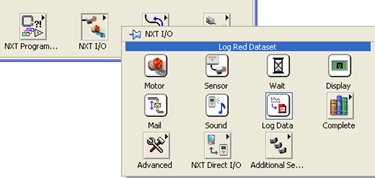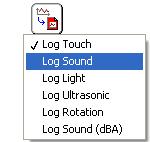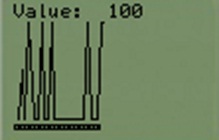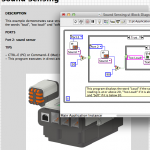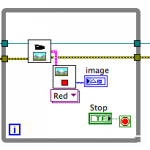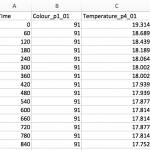A simple way to log data in LabView involves specifying a time interval between each measurement and the time interval over which the recording takes place.
For example, we could measure the sound level for 5 minutes, with an interval of 5 seconds between each measurement.
To set this up, first select the Log Data command from NXT Robotics > NXT I/O > Log Data:
Insert this command, and select Log Sound from the drop-down menu:
Notice that the icon has a red background. That means we store the data in the red data set. But we also have a green and blue data sets available. They are located in the submenu complete > logging. They look like this: So what do we mean with a red, green or blue data set? Well, when we log the data in this way the data is stored as a file on the NXT brick. If we use the red dataset the datas are saved in a file called RedData.dat, the green data set is saved in a file called GreenData.dat and the blue dataset, not surprisingly BlueData.dat. In addition, we need to configure our logging. We do this with the modifier parameters. We moves the mouse pointer over the lower left corner, right click and choose create constant. Now it looks like this:
So what do we mean with a red, green or blue data set? Well, when we log the data in this way the data is stored as a file on the NXT brick. If we use the red dataset the datas are saved in a file called RedData.dat, the green data set is saved in a file called GreenData.dat and the blue dataset, not surprisingly BlueData.dat. In addition, we need to configure our logging. We do this with the modifier parameters. We moves the mouse pointer over the lower left corner, right click and choose create constant. Now it looks like this:
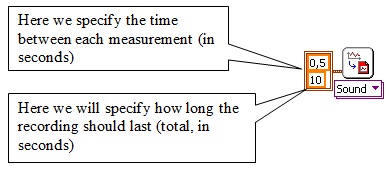 The values given here are default values. We should have a measurement every 5 seconds for 5 minutes, that will be 300s (5min = 300s). We select the text tool and change the values
The values given here are default values. We should have a measurement every 5 seconds for 5 minutes, that will be 300s (5min = 300s). We select the text tool and change the values
We must also choose the port where the sound sensor is connected. We hover up in the middle, right click and choose create constant:

That’s it. We can now press run and run the program. During the datalogging, the data will be plotted on the NXT screen as shown below:
We also get the latest measurement of the screen. In this case, the equal to 100, but it is important to be aware that this is not given in decibels, but decibels given as percentages.
Svein-Tore Narvestad
Latest posts by Svein-Tore Narvestad (see all)
- Create apps for NXT with MIT App Inventor - 3 August 2016
- RicEditor tutorial: Create a cannon game - 28 October 2013
- Create your own games with “RIC” files - 27 August 2013
- How to update the NXT firmware in LabVIEW - 19 August 2013
- Datalogging in LabVIEW: Timed datalogging - 2 June 2013
